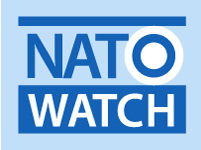By Peter Burt*
6 January 2023
In November 2021 NATO Watch published a critique of NATO's approach to the use of artificial intelligence (AI) for military purposes. This article provides a brief update to the critique following the meeting of Defence Ministers in Brussels in October 2022, when NATO announced more details of its approach to the use of AI and digital technologies in warfare.
At the meeting NATO Defence Ministers agreed to establish a Data and Artificial Intelligence Review Board to govern the development and use of AI and data across NATO, and at the same time a summary of NATO’s Autonomy Implementation Plan was published. The Review Board is intended to govern the development and use of AI and data across NATO, with the aim of ensuring that AI is used ethically in line with NATO's principles of responsible use which were published in October 2021. The Review Board has been tasked with developing an AI certification standard, including quality controls and risk mitigation, that will help align AI and data projects with the principles of responsible use.
The Review Board is also intended to serve as a platform to exchange best practices and guide product developers and operational end-users throughout the development phase of AI systems. It will also guide the implementation of AI within NATO and support NATO members in their AI efforts. NATO's communique specifically states that the Review Board “must ensure that its outputs do not raise unnecessary barriers to adopting AI at the speed of relevance”, raising questions about how effective it will be in controlling technology development. Each NATO nation will nominate a national nominee to serve on the Board. To date members have yet to be nominated, and the effectiveness of the Board will clearly depend very much on the quality of members who are nominated and their understanding of AI ethics.
NATO's AI Implementation Plan sets out how NATO and its member states will adopt autonomous systems to support and undertake core tasks. Again, harmonisation and interoperability are key themes, both in terms of autonomous systems themselves and military doctrine on how they will be used. The security of autonomous systems is also emphasised, with the aim of ensuring that security measures needed to protect them from a range of threats are developed and implemented. The plan sets out an aspiration to regularly conduct exercises and operational experimentation with autonomous systems to drive forward their deployment at scale in NATO operations.
The Defence Ministers meeting also approved NATO’s first Digital Transformation vision. NATO hopes that by 2020 a digital transformation will have enabled the alliance to fight wars across multiple domains, ensure interoperability of military forces, enhance situational awareness for forces in action, and allow data to drive its decision-making.
Shortly after the Defence Ministers met the Canadian Government announced that it would be hosting a new NATO military technology innovation centre at Halifax. The centre will act as the North American hub of the Defence Innovation Accelerator for the North Atlantic (DIANA). The centre is intended to bring together tech sector start-ups, private sector companies, and academics to assist NATO in staying 'ahead of the game' in developing military and security technologies, and will provide access to a network of technology accelerator sites and test centres across North America and Europe.
NATO has identified nine emerging and disruptive technologies as fruitful areas for research and development, and has established a €1 billion NATO Innovation Fund to develop these dual-use technologies: AI, data exploitation, quantum-enabled technologies, autonomy, biotechnology and human enhancement, novel materials, energy, propulsion and space. Among these, AI and data are NATO's top priorities for investment and exploitation – particularly with the aim of enabling multi-domain operations and enhancing situational awareness.
Although NATO communiques stress measures to ensure that AI systems are used responsibly and lawfully, study of the detail indicates that these initiatives are as much about enabling the implementation of AI, autonomous systems, and novel technologies as they are about controlling and regulating them to mitigate the risks they pose. The underlying suggestion that NATO will use AI technologies responsibly, but its adversaries will not, is questionable, to say the least. Ultimately, the new initiatives are intended to ensure that NATO maintains its technological edge over adversaries and is able to prevent adversaries from countering NATO's autonomous systems during warfare. The UK Ministry of Defence's recently unveiled policies on the military uses of AI are open to identical criticisms.
Despite the seeming inevitability of military AI systems and new technologies for warfighting, there are a range of measures which could be used to prevent their development, such as establishing international treaties and norms, developing confidence-building measures, introducing international legal instruments, and adopting unilateral control measures. NATO should be far more involved in developing such measures on the international stage, rather than focusing on advancing its own military technologies at any cost.
* Peter Burt is a researcher at Drone Wars UK where he works on issues relating to newly emerging military technologies. Previously he was Director of the Nuclear Information Service, undertaking research into the costs and risks of the UK’s nuclear weapons programme
